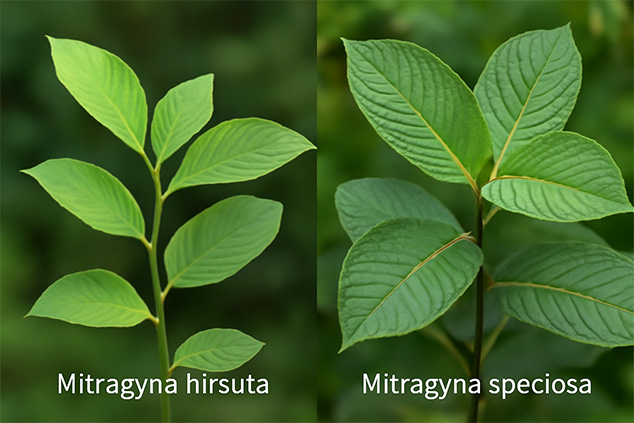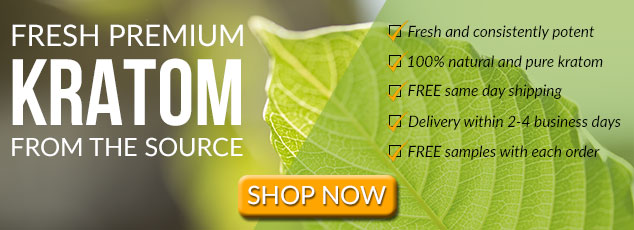As the popularity of kratom grows, there is increasing interest in and awareness of the other plants in the same genus, namely of Mitragyna hirsuta, a close cousin of Mitragyna speciosa. Many sources refer to hirsuta as an alternative to speciosa.
So, how does Mitragyna hirsuta compare vs. Mitragyna speciosa? Should you be on the lookout for a hirsuta vendor?
Let’s compare and find out.
The Mitragyna Genus
Mitragyna speciosa is not the only plant in the family. In addition to kratom, there are six other trees in the Mitragyna genus. They grow across various countries across Southeast Asia, as well as in Africa.
However, they aren’t the same.
Despite some similarities and some alkaloids that the varieties have in common, there are rather stark differences between the different trees in the Mitragyna genus.
This is also true about Mitragyna hirsuta and speciosa. Let’s break it down.
What Is Mitragyna Speciosa?
Mitragyna speciosa is a tall tropical tree from the Coffee plant family and the Mitragyna genus, which grows in Indonesia, Thailand, Malaysia, and Papua New Guinea. Commonly known as kratom, it is used in powder and tea form for a variety of effects, primarily pain relief and relaxation.
Main Alkaloids in Mitragyna Speciosa
The powerful effects of Mitragyna speciosa, aka kratom, are due to its alkaloid. Current research on kratom indicated that the herb contains at least 25 various alkaloids and 40 total beneficial compounds. In addition to alkaloids, kratom also contains polyphenols, flavonoids, and other compounds.
The primary alkaloids in this variety of Mitragyna are mitragynine and 7-hydroxymitragynine. You can find them in more abundant quantities than any other alkaloids and compounds Mitragynine content in kratom is approximately 60%, whereas 7-mitragynine is just under 2%.
Both alkaloids interact with the opioid receptors in the human brain. They are partial opioid agonists. Therefore, their use results in similar or even more potent pain-relieving effects than opioid medication. However, the alkaloids interact with the brain differently, making kratom about as addictive as coffee and without the dangerous respiratory depression that you can expect from the use of opioids.
Uses and Effects of Mitragyna Speciosa
The effects of Mitragyna speciosa vary depending on the vein and strain as well as dosage. Red vein kratom strains and higher doses result in pain-relieving, relaxing, and sedative effects. White vein kratom strains and low doses yield the opposite effects. They are stimulating and mood-boosting.
Meanwhile, green and yellow strains are rather moderate and offer a balanced mix of effects – mild pain relief and moderate relaxation as well as improved mood and an energy boost.
Most kratom is sold in loose powder form, which is used to brew tea, toss and wash, and mix in with liquids such as juice, smoothies, or yogurt. However, capsules, tinctures, and various skin products such as soap are available too.
What Is Mitragyna Hirsuta?
Another variety of the Mitragyna genus, Mitragyna hirsuta, also referred to as Kra Thum Khok, grows in Thailand, Vietnam, and Cambodia. While it is visually highly similar to speciosa, hirsuta is a tree that doesn’t grow as tall as its speciosa cousin.
Main Alkaloids in Mitragyna Hirsuta
As opposed to Mitragyna speciosa, hirsuta does not owe its properties to mitragynine r 7-hydroxymitragynine. Instead, its most abundant alkaloid is mitraphylline. The same alkaloid is present in kratom, though in smaller quantities, as well as in the bark of Cat’s Claw.
A few limited studies on mitraphylline show highly promising anti-inflammatory and anticancer properties.
Uses and Effects of Mitragyna Hirsuta
Various vendors offer Mitragyna Hirsuta as a kratom alternative, recommending taking it in large doses, usually up to 25g in ta form. Those who have tried it report feeling mild relaxing effects that ease anxiety and provide a slight mood boost, yet in lower intensity as you can expect from Mitragyna speciosa.
Yet, slightly better mood and mild anxiety relief are, in general, the most you can expect from this plant. It does not provide pain relief and does not help with opioid withdrawal due to the lack of alkaloids that Mitragyna speciosa possesses.

Mitragyna Hirsuta vs. Mitragyna Speciosa: The Bottom Line
While Mitragyna hirsuta does have some relaxing and other beneficial effects, those are not equivalent in their extent and intensity as high-quality Mitragyna speciosa.
Moreover, various buyers have pointed out that they suspect that many vendors disguise low-quality kratom as Mitragyna hirsuta, thus making its use as a kratom substitute non-effective. Especially because of the high doses recommended by the vendors.
Precautions
Taking the wrong herb can result in increasing kratom tolerance without knowing it. You may also end up experiencing kratom side effects such as nausea and vomiting.
In addition to that, due to the increase of farmers who have switched to Mitragyna from other crops due to high demand, many lack experience working with any plants of the Mitragyna genus.
As a result, there is an extremely high risk of buying fake or low-quality Mitragyna speciosa and Mitragyna hirsuta. Only third-party independent lab tests are able to determine the true quality and purity of both
So, you should always thoroughly review those on any vendor’s website. If you see any issues with the tests or any information about either one of the herb does not seem genuine or credible, it is best to avoid such vendor, especially if they are not US-based. Otherwise, you risk exposing yourself to products of questionable origin and quality.
As far as the Mitragyna hirsuta vs. Mitragyna speciosa debate is concerned, Mitragyna hirsuta does possess some beneficial relaxing, anticancer, and anti-inflammatory properties. Therefore, there may be benefits of taking authentic Mitragyna hirsuta. Nonetheless, it is not a substitute for its cousin speciosa.
Regardless of its beneficial uses, one must be extremely cautious when selecting a vendor. This is true for both Mitragyna hirsuta or Mitragyna speciosa. Due to common scams and misinformation in the industry, it is possible that you may buy an inauthentic or low-quality product.
Have you ever tried Mitragyna hirsuta? What was your experience with it like? Would you recommend trying Mitragyna hirsuta vs. Mitragyna speciosa? Why or why not?


Leave a Reply